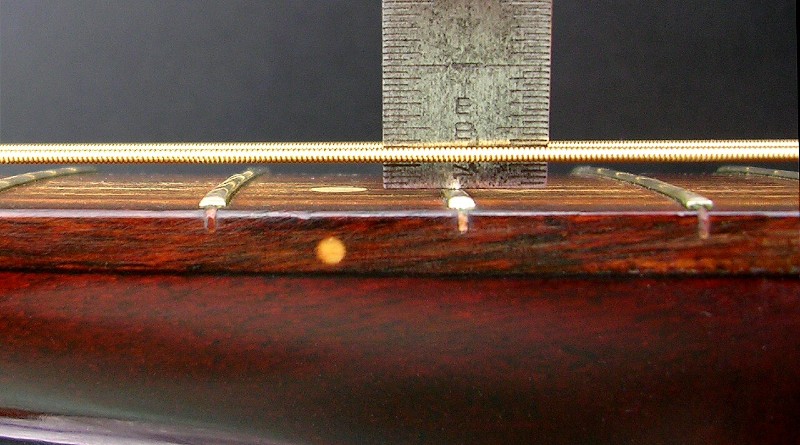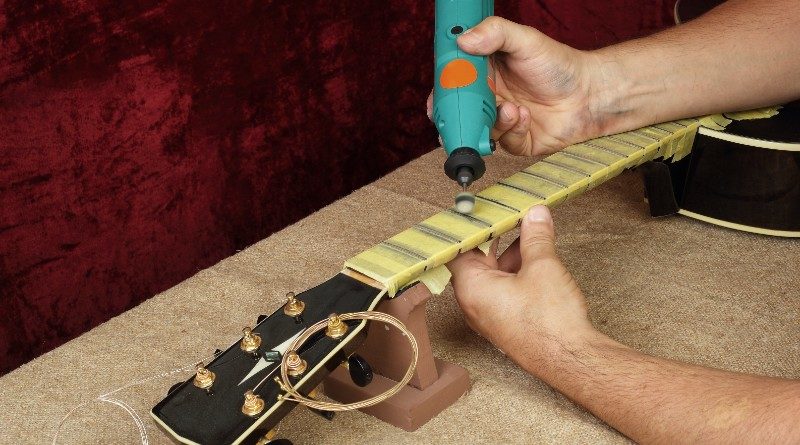There are few guitar problems that rank higher, as far as irritability goes, than fret buzz. It kills your tone and it slices through a mix in the worst possible way. Luckily, the root cause is usually pretty easy to identify and remedy.
In this KillerGuitarRigs Guide you’ll be learning:
- What is fret buzz?
- What are the most common causes of fret buzz, and how it can be fixed?
Contents
What is Fret Buzz?
Fret buzz is the name given to the annoying “buzzing” noise that occurs when a string partially comes into contact with a fret as it is plucked or strummed (not to be confused with string noise from playing). As the string vibrates, it strikes the offending fret repeatedly, creating the notorious buzz that most of us hate.
Interestingly enough, in certain styles of flamenco guitar, fret buzz is actually desirable, although outside of that, it’s usually not an attribute many people put up with, let alone look for.
Fret buzz is easiest to identify when it happens with open strings, but in many cases it only occurs when certain notes are fretted.
What are the Most Common Causes of Fret Buzz, and how can it be Fixed?
The most common causes of fret buzz are widespread, which does make it easy to isolate the source of the problem, and to fix it. Some fixes can be made with nothing more than practice, or adjustments, while others may require replacing parts.
Unfortunately (and I’ve personally experienced this), fret buzz can also be a gremlin, and just when you think you’ve fixed it, it pops up somewhere else on the fretboard. But, by methodically working your way through these tips, there is a good chance you’ll isolate, and remedy the issue you’re facing.
Keep reading to find out more.

Technique
Before diving into problems with your guitar and eventually reaching for the tool kit, the first thing you should investigate is whether or not your technique is the cause of your buzzing frets.
There are three main technique problems that can cause buzzing frets:
- Not pressing hard enough on the strings
- Pressing down too far behind the fret
- Strumming too hard
Fortunately, as far as changes to technique go, these are some of the easiest to correct. If you do suspect that light fingers may be the issue, try to make a conscious effort to push down harder. If this is too tough, or uncomfortable, you could potentially try reducing your strings to a lighter gauge.
If you’re confident that you’re pushing down hard enough, take a look at where you’re pushing down. You should be pressing the string right in the middle between the frets. If you push closer to, or even on the fret, you probably won’t hear any fret buzz, but, if you push down too high above the fret, the string will almost certainly buzz against the fret when played.
This can be a harder habit to break, but again, take the time to look where you’re placing your fingers, and if they are too high, move them to the center point between the frets to cure the buzz.
Lastly, if you’re a particularly heavy strummer, try reducing the intensity of your playing a little. If you get carried away with heavy strumming and your technique isn’t perfect you may strike the strings at too sharp an angle, resulting in the strings vibrating up and down toward and away from the frets, rather than from side to side.
If, once you’ve accounted for technique, you are still experiencing fret buzz, there’s a good chance there’s an issue with your guitar that can most likely be rectified.
Height of Action

A nice low action is something that most guitarists actively look for, the problem is when it gets too low. This brings the strings too close to the fretboard, which can frequently cause fret buzz, and it can also cause notes to choke out when playing bends.
Action height can be adjusted in a couple of ways (we do have a full guide on action if you want to get deeper).
On an electric guitar, you can try raising the height of the saddle on the string that is buzzing. Alternatively, a truss rod adjustment may be necessary. If your guitar doesn’t have enough neck bow, there won’t be enough distance between the strings and the frets.
When adjusting your truss rod, do everything in small increments, around ⅛ to ¼ of a turn at a time. Check your adjustments for effectiveness and continue only if necessary.
If you’re having fret buzz issues on an acoustic guitar, you’re unlikely to have individually adjustable saddles that you can raise to lift your action. Your only alternative will be to shim the saddle. To do this, you’ll need to remove your strings, and lift out the saddle from the bridge.
You only need to raise it a millimeter or two, so whatever you use as a shim should be very thin. A small shaving of wood is always a good choice. Place the shim in the bridge recess then put the saddle back into position before restringing.
If your fret buzz is only prevalent at the higher frets and you don’t want to raise your saddles, you may need to shave down your nut. To do this you can either file out the slots or shave the bottom. If you only need to adjust one string, it’s better to file out the slot of the string that’s buzzing.
If you choose to file out the slot(s), take extreme care and go slowly. If you shave down too far you can cause fret buzz issues at the top of the fretboard, too. If you’re having issues with multiple strings buzzing, you can gently remove the nut, and sand the bottom.
Place your sandpaper on a flat sturdy surface and gently rub the base of the nut to remove some material. Again, less is more when it comes to removing material from the nut, take off a little and check the results until you’re happy.
Fret Imperfections
On any guitar, no matter the setup, the frets should all be level with one another. If your guitar has uneven frets, this is inevitably going to cause fret buzz, and there’s nothing an action adjustment or technique shift can do to solve it.
There are a couple of potential causes of uneven frets. First of all, the frets not being installed correctly from the factory. Alternatively, frets that wear unevenly over years of play can eventually cause buzz, too.
To check if your frets are level, take a fret rocker, a credit card or anything else with a straight edge of a similar size, and lay it over 3 frets simultaneously. You should not be able to rock it back and forth if the frets are level.
If when checking your frets, you’re able to rock the card or straight edge, you’ve identified an uneven fret. You can repeat this for the whole fretboard, or, if you only have one problem area, you can simply check the frets that you suspect are buzzing specifically.
Unless you have significant experience in guitar setups, including fret dressing, adjustments to your frets should always be done by a professional luthier. Your luthier will either perform a service known as fret leveling, in which they manually check every fret and file anything too high down by hand, or they may recommend a PLEK service.
A PLEK service can be quite costly, but if you’re serious about fixing fret buzz and uneven frets are the problem, there’s no better way. A PLEK machine is essentially a CNC machine that measures the height of all of your frets, and using a computerized blade, shaves off and recrowns any problem areas.
If you’re curious about PLEK machines, and want to know more, check out our Ultimate Guide to the PLEK Machine for Guitars post.
Worst case scenario, they might suggest you get a refret – more on that here.
Recent String Changes
If you’ve recently changed your strings and you’ve just noticed some buzzing, the strings themselves could be to blame. Whether you simply bought the wrong gauge, or you’ve intentionally changed to something heavier or lighter, the change in tension can have a significant effect on the neck relief.
Heavier strings increase tension, while lighter strings will reduce tension. Typically fret buzz is introduced when lighter strings are installed, as this introduces more back bow, bringing the frets closer to the strings.
The solution to fret buzz caused by a change in string gauge is always a set up. Any time you change gauge, make adjustments to your action and neck relief to ensure that the strings are sitting at the correct height above the frets.
Poor Quality Assurance
Especially on budget guitars, particularly those made by brands without widely recognized names, the QA process in the factory the guitar was built in might miss all kinds of manufacturing defects that are simply not recoverable.
If you bought your guitar new and you’re struggling to remove fret buzz, no matter how many adjustments you make, you may have a lemon on your hands. If this is the case, you may be entitled to a refund or exchange from the store you purchased it from as long as you’re within the warranty window.
Twisted Neck
I’ve saved this one for last because it’s probably the worst thing that you could find on your guitar. A twisted, or warped neck is exactly how it sounds – the neck of your guitar twisting like a corkscrew, albeit less dramatically.
Because guitars are usually made of wood, a natural product, they will react to changes in humidity. The pores of the wood can take on moisture from the air, causing expansion, and contraction when humidity is reduced, and the moisture is expelled. As this happens, warps and twists can be introduced.
As you can imagine, the twisting of the neck will lift the frets on one side and lower them at the other. When this happens, fret buzz and choke outs during bends are common side effects. Sadly, if your guitar’s neck is twisted, there is little that can be done to fix it, especially with amateur tools and techniques.
If your guitar is equipped with a bolt on neck, you can always replace it directly. Necks don’t usually come with tuning hardware, so you’ll not only need to have the confidence to replace the neck, but also to remove and reinstall your tuning machines. If you play a set neck guitar like a Les Paul, then you will absolutely need the skills and tools of an experienced luthier. Even then, there’s no guarantee that they can salvage it.
Final Thoughts on Finding Fret Buzz and Fixing it
Most fret buzz is caused by improper setup, so having the ability to make these adjustments yourself can be a huge time and money saver. Fighting against unidentified fret buzz is bound to drive any guitarist crazy, so by following these steps and making adjustments as required, you should be well equipped to correct any issues you might be having.
You might also like these related articles:


